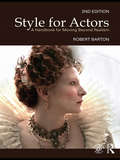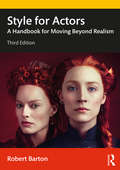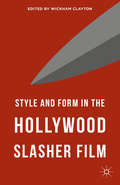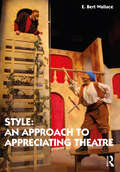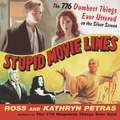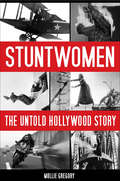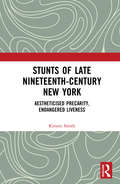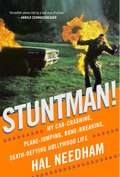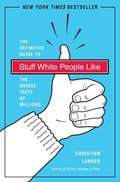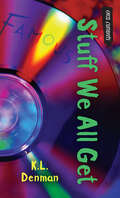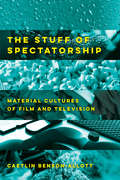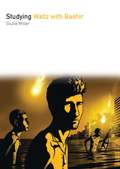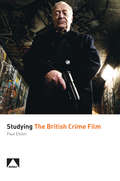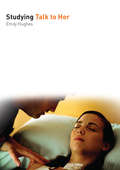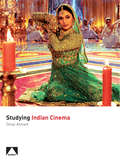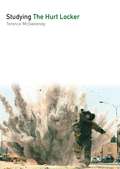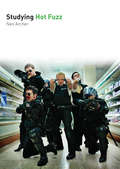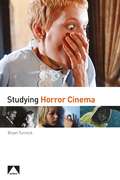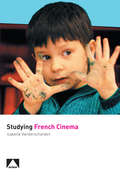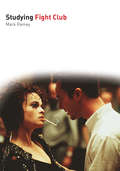- Table View
- List View
Style For Actors: A Handbook for Moving Beyond Realism
by Robert Barton"Style is a journey from tourist to native. It is living in the world of the play, not just visiting it." - from Chapter One Anyone who has ever struggled with capes, fans, swords, doublets and crinolines should make Style for Actors 2nd Edition their constant companion. Robert Barton has completely updated his award winning handbook for the 21st century with contemporary references and up-to-date illustrations. This is the definitive guide to roles in historical drama. The past is a foreign country, and this outstanding book is concerned with exploring it from the actor’s point of view. Specific guides range from Greek, Elizabethan, Restoration and Georgian theatre to more contemporary stylings, including Futurism, Surrealism and Postmodernism. Barton takes great care to present the actor with the roles and genres that will most commonly confront them. His analysis moves from entire genres to specific scenes and characters. A huge resource of nearly 150 practical exercises helps a newfound understanding of style to make the leap from page to performance.
Style for Actors: A Handbook for Moving Beyond Realism
by Robert BartonStyle for Actors is an award-winning handbook and the definitive guide to roles in historical drama. Anyone who has ever struggled with capes, fans, swords, doublets and crinolines should make this third edition their constant companion. The past is a foreign country, and this outstanding book is concerned with exploring it from the actor's point of view. Specific guides to each major period give readers a clear map to discover a range from Greek, Elizabethan, Restoration and Georgian theatre to more contemporary stylings, including Futurism, Surrealism and Postmodernism. New material in this edition covers Commedia dell'arte and non-Western forms of theatre, theatrical fusion and developments in musicals and Shakespeare. The book’s references, images, resource lists and examples have all been updated to support today's diverse performers. Robert Barton takes great care to present the actor with the roles and genres that will most commonly confront them. Containing a huge resource of nearly 150 exercises, suggestions for scene study and applications not only for theatrical performance but also for stylistic challenges in the reader’s own offstage life, this book is an invaluable resource for students and practitioners of acting and drama.
Style and Form in the Hollywood Slasher Film
by Wickham ClaytonStyle and Form in the Hollywood Slasher Film fills a broad scholastic gap by analysing the elements of narrative and stylistic construction of films in the slasher subgenre of horror that have been produced and/or distributed in the Hollywood studio system from its initial boom in the late 1970s to the present.
Style: An Approach To Appreciating Theatre
by E. Bert WallaceStyle: An Approach to Appreciating Theatre offers brief, readable chapters about the basics of theatre as a starting point for discussion, and provides new adaptations of classic plays that are both accessible to students learning about theatre and fit for production. In this text, style is the word used to describe the various ways in which theatre is done in real space and time by humans in the physical presence of other humans. The book uses style, the "liveness" of theatre that makes it distinct from literature or history, as a lens to see how playwrights, directors, designers, and actors bring scripts to life on stage. Rather than focusing on theatre history or literary script analysis, it emphasizes actual theatrical production through examples and explores playscripts illustrating four theatrical styles: Realism, Theatricalism, Expressionism, and Classicism. Susan Glaspells Realistic play Trifles is presented as written, while The Insect Play by the Brothers apek, The Hairy Ape by Eugene ONeill, and Antigone by Sophocles are original, full-length adaptions. Style: An Approach to Appreciating Theatre is the perfect resource for students of Theatre Appreciation, Introduction to Theatre, Theatrical Design, and Stagecraft courses.
Stupid Movie Lines: The 776 Dumbest Things Ever Uttered on the Silver Screen
by Ross Petras Kathryn PetrasThe creme de la crud of screen history "War! War! That's all you think of, Dick Plantagenet! You burner! You pillager!" --Virginia Mayo as Lady Edith to George Sanders in King Richard and the Crusaders (1954) "Visits? That would indicate visitors. " --Army captain learning of alien visits in Plan 9 from Outer Space (1959) "When I'm sitting here with you, I don't even think about the slime people. " --Hero to heroine in The Slime People (1962) "Suck the coffin mushroom now. " --The Ultimate Vampire (1991) "This is bad. " --Leonardo DiCaprio as the you-know-what hits the you-know-what in Titanic (1997)
Stupid Cupids (Bad News Ballet #3)
by Jahnna N. Malcolm[from the back cover] "Valentines Day is coming up, and the girls at the Deerfield Academy of Dance have boys on the brain. It all starts when a new student enrolls in their ballet class--a boy. And he's not just a good dancer...he's cute, too! Then Zan, McGee, Rocky, Mary Bubnik, and Gwen discover that Annie, their favorite ballet teacher, doesn't have a date for Valentine's Day. The gang may have boy problems ... but their teacher is much more important! So the girls (A.K.A "The Cupids") now have a mission: Find Annie the perfect boyfriend. Who will they select as their teacher's Valentine--Ralph, the janitor? Stan, a black belt in Tae Kwon Do? With cupids like these on the case...look out, Annie!" There are more funny situations in store for these ballet school friends who like each other more than they like ballet. The Bookshare collection has the whole series. Check out #1 The Terrible Try outs, #2 Battle of the Bunheads, #4 Who Framed Mary Bubnik, #5 Blubberina, #6 Save D.A.D., #7 The King and Us, #8 Camp Clodhopper, #9 Boo Who?, and #10 A Dog Named Toe Shoe.
Stuntwomen: The Untold Hollywood Story (Screen Classics)
by Mollie Gregory“Gives voice to the women who have risked their lives for a few (perilous) moments on the big screen. A fascinating look at a risky profession.” —The Washington PostThey’ve traded punches in knockdown brawls, crashed biplanes through barns, and raced to the rescue in fast cars. They add suspense and drama to the story, portraying the swimmer stalked by the menacing shark, the heroine dangling twenty feet below a soaring hot air balloon, or the woman leaping nine feet over a wall to escape a dog attack. Only an expert can make such feats of daring look easy, and stuntwomen with the skills to perform—and survive—great moments of action in movies have been hitting their mark in Hollywood since the beginning of film.Here, Mollie Gregory presents the first history of stuntwomen in the film industry from the silent era to the twenty-first century. In the early years of motion pictures, women were highly involved in all aspects of film production, but they were marginalized as movies became popular, and more important, profitable. Capable stuntwomen were replaced by men in wigs, and very few worked between the 1930s and 1960s. As late as the 1990s, men wore wigs and women’s clothes to double as actresses, and were even “painted down” for some performances, while men and women of color were regularly denied stunt work.For decades, stuntwomen have faced institutional discrimination, unequal pay, and sexual harassment even as they jumped from speeding trains and raced horse-drawn carriages away from burning buildings. Featuring sixty-five interviews, Stuntwomen showcases the absorbing stories and uncommon courage of women who make their living planning and performing action-packed sequences that keep viewers’ hearts racing.
Stunts of Late Nineteenth-Century New York: Aestheticised Precarity, Endangered Liveness
by Kirstin SmithStunts of Late Nineteenth- Century New York: Aestheticised Precarity, Endangered Liveness examines the emergence of stunts in the media, politics, sport and art of New York at the turn of the twentieth century. This book investigates stunts in sport, media and politics, demonstrating how these risky performances tapped into anxieties and fantasies concerning work, freedom, gendered/ raced/ classed bodies and the commodifi cation of human life. Its case studies examine bridge jumping, extreme walking contests, stunt journalists such as Nellie Bly, and cycling feats including Annie Londonderry’s round- the- world venture. Supported by extensive archival research and Performance Studies theorisations of precarity, liveness and surrogation, Smith theorises an under- examined form which is still prevalent in art, politics and commerce, to show what stunts reveal about value, risk and human life. Suitable for scholars and practitioners across a range of subjects, from Performance Studies to gender studies, to media studies, Stunts of Late Nineteenth- Century New York explores how stunts turned everyday precarity into a spectacle.
Stuntman!: My Car-Crashing, Plane-Jumping, Bone-Breaking, Death-Defying Hollywood Life
by Hal NeedhamYep that's me, Hal Needham, on the cover doing a fire stunt. When you're on fire you don't dare breathe because if you do, you'll suck those flames right down your throat. I was Hollywood's highest paid stuntman so I should know.I wrecked hundreds of cars, fell from tall buildings, got blown up, was dragged by horses, and along the way broke 56 bones, my back twice, punctured a lung and knocked out a few teeth...I hung upside down by my ankles under a bi-plane in The Spirit of St. Louis, jumped between galloping horses in Little Big Man, set a world record for a boat stunt on Gator, jumped a rocket powered pick-up truck across a canal for a GM commercial, was the first human to test the car airbag-and taught John Wayne how to really throw a movie punch.Life also got exciting outside of the movie business. I had my Ferrari stolen right from under my nose, flew in a twin-engine Cessna with a passed out pilot, rescued the cast and crew from a Russian invasion in Czechoslovakia, and once took six flight attendants on a date. I owned the Skoal-Bandit NASCAR race team, the sound-barrier breaking Budweiser Rocket Car and drove a souped-up, fake ambulance in a "little" cross-country race called The Cannonball Run, which became the movie I directed by the same name. Oh yeah, I also directed Smokey and the Bandit, Hooper and several other action/comedy movies that I liked a bunch. I was a sharecropper's son from the hills of Arkansas who became a Hollywood stuntman. That journey was a tough row to hoe. I continually risked my life but that was the career I chose. I was never late to the set and did whatever I had to do to get the job done.Hollywood's not all sunglasses and autographs. Let me tell you a few stories...
Stuff White People Like: The Definitive Guide to the Unique Taste of Millions
by Christian LanderThey believe they're unique, yet somehow they're all exactly the same. You know who they are: They're white people. And they're here and you're gonna have to deal. Fortunately, here's a book that investigates, explains, and offers advice for finding social success with the Caucasian persuasion. So kick back on your IKEA couch and lose yourself in the ultimate guide to the unbearable whiteness of being.
Stuff We All Get: (stuff We All Get) (Orca Currents)
by K.L. DenmanFifteen-year-old Zack finds a home made CD with the word Famous written on it. Lonely and bored while suspended from school, he puts the CD on and loses himself in the music. Zack has sound-color synesthesia. He sees colors when he hears music, and the music on the Famous CD causes incredible patterns of color for him. Zack becomes obsessed with the girl on the CD and tries to find her. He tracks down the singer, Jolene, in a cafe where she works while she dreams of the big time. He convinces her to let him help her achieve her dreams, but soon discovers that in her quest for fame, Jolene has done a lot of damage. Stuff We All Get is a gentle critique of celebrity culture in North America. Also available in French.
The Stuff of Spectatorship: Material Cultures of Film and Television
by Caetlin Benson-AllottFilm and television create worlds, but they are also of a world, a world that is made up of stuff, to which humans attach meaning. Think of the last time you watched a movie: the chair you sat in, the snacks you ate, the people around you, maybe the beer or joint you consumed to help you unwind—all this stuff shaped your experience of media and its influence on you. The material culture around film and television changes how we make sense of their content, not to mention the very concepts of the mediums. Focusing on material cultures of film and television reception, The Stuff of Spectatorship argues that the things we share space with and consume as we consume television and film influence the meaning we gather from them. This book examines the roles that six different material cultures have played in film and television culture since the 1970s—including video marketing, branded merchandise, drugs and alcohol, and even gun violence—and shows how objects considered peripheral to film and television culture are in fact central to its past and future.
Studying Waltz with Bashir (Studying Films)
by Giulia MillerOn its release in 2008, Ari Folman's animated documentary Waltz with Bashir was heralded as a brilliant and original exploration of trauma, and trauma's impact on memory and the recording of history. But it is surprising that although the film is seen through the eyes of one particular soldier, a viewpoint portrayed using highly experimental forms of animation, this has not prevented Waltz with Bashir from being regarded as both an 'autobiographical' and 'honest' account of the director's own experiences in the 1982 Lebanon war. In fact, the film won several documentary awards, and even those critics focusing on the representation of trauma suggest that this trauma must be authentic. In this sense, it is the documentary form rather than the animation that has had the most influence upon critics.As Studying Waltz with Bashir will show, it is the tension between the two forms that makes the film so complex and interesting, allowing for multiple themes and discourses to coexist, including Israel's role during the Lebanon War and the impact of trauma upon narrative, but also the representation of Holocaust memory and its role in the formation of Israeli identity. In addition to these themes that coexist by virtue of the film's unusual animated documentary format, Waltz with Bashir can also be discussed in relation to a broad range of contexts; for example, the representation of war in film, the history of Israeli Holocaust cinema, and recent trends in experimental animation, such as Richard Linklater's Waking Life (2001) and A Scanner Darkly (2006), as well as Folman's most recent live action/animation work The Congress (2013).
Studying the British Crime Film
by Paul ElliottEver since its inception, British cinema has been obsessed with crime and the criminal. One of the first narrative films to be produced in Britain, the Hepworth's 1905 short Rescued by Rover, was a fast-paced, quick-edited tale of abduction and kidnap, and the first British sound film, Alfred Hitchcock's Blackmail (1930), centered on murder and criminal guilt. For a genre seemingly so important to the British cinematic character, there is little direct theoretical or historical work focused on it. The Britain of British cinema is often written about in terms of national history, ethnic diversity, or cultural tradition, yet very rarely in terms of its criminal tendencies and dark underbelly. This volume assumes that, to know how British cinema truly works, it is necessary to pull back the veneer of the costume piece, the historical drama, and the rom-com and glimpse at what is underneath. For every Brief Encounter (1945) there is a Brighton Rock (2010), for every Notting Hill (1999) there is a Long Good Friday (1980).
Studying the British Crime Film (Studying British Cinema Ser.)
by Paul ElliottEver since its inception, British cinema has been obsessed with crime and the criminal. One of the first narrative films to be produced in Britain, the Hepworth’s 1905 short Rescued by Rover, was a fast-paced, quick-edited tale of abduction and kidnap, and the first British sound film, Alfred Hitchcock’s Blackmail (1930), centered on murder and criminal guilt. For a genre seemingly so important to the British cinematic character, there is little direct theoretical or historical work focused on it. The Britain of British cinema is often written about in terms of national history, ethnic diversity, or cultural tradition, yet very rarely in terms of its criminal tendencies and dark underbelly. This volume assumes that, to know how British cinema truly works, it is necessary to pull back the veneer of the costume piece, the historical drama, and the rom-com and glimpse at what is underneath. For every Brief Encounter (1945) there is a Brighton Rock (2010), for every Notting Hill (1999) there is a Long Good Friday (1980).
Studying Talk to Her
by Emily HughesTalk to Her (2002) is a hugely rich and interesting, but ambiguous, film which met with both popular success and critical acclaim. The film won the 2003 Oscar for best original screenplay and has been hailed by some critics as Pedro Almodóvar's masterpiece. But like most of Almodóvar's films, little is clear cut; the characters are complex and our affinity and empathy for them shifts throughout the film. In Studying Talk to Her, Emily Hughes provides an in-depth analysis of both the formal elements of the film (narrative, genre, auteur study) and the themes and issues that arise, including the social context of modern Spain and the old traditional iconography, the shifting attitudes towards gender, and, crucially, the uneasy, morally ambiguous depiction of rape and the spectator's reaction to it.
Studying Talk to Her (Studying Films)
by Emily HughesTalk to Her (2002) is a hugely rich and interesting though ambiguous film that met with both popular success and critical acclaim. The film won an Oscar for best original screenplay and has been hailed by some critics as Pedro Almodóvar's masterpiece. Yet like most of Almodóvar's films, little is clear cut. The characters are complex and our affinity and empathy for them shifts throughout the film. In Studying Talk to Her, Emily Hughes provides an in-depth analysis of both the formal elements of the film (its narrative, genre, and auteur study) and the themes and issues it raises, discussing the social context of modern Spain and its old, traditional iconography; shifting attitudes towards gender; and, crucially, the film's uneasy, morally ambiguous depiction of rape and the spectator's reaction to it.
Studying Indian Cinema (Auteur)
by Omar AhmedThis book traces the historical evolution of Indian cinema through a number of key decades. The book is made up of 14 chapters with each chapter focusing on one key film, the chosen films analysed in their wider social, political and historical context whilst a concerted engagement with various ideological strands that underpin each film is also evident. In addition to exploring the films in their wider contexts, the author analyses selected sequences through the conceptual framework common to both film and media studies. This includes a consideration of narrative, genre, representation, audience and mise-en-scene. The case studies run chronologically from Awaara (The Vagabond, 1951) to The Elements Trilogy: Water (2005) and include films by such key figures as Satyajit Ray (The Lonely Wife), Ritwick Ghatak (Cloud Capped Star), Yash Chopra (The Wall) and Mira Nair (Salaam Bombay!).
Studying The Hurt Locker (Studying Films)
by Terence McSweeneyIn this vibrant and dynamic book-length study drawing on a broad tapestry of research, Terence McSweeney offers an exploration of The Hurt Locker (2009), its stylistic and narrative devices, its cultural impact, its reception, and its relationship to the genre of the war film. McSweeney places the film in a richly textured historical, political, and industrial context, arguing that The Hurt Locker is part of a long tradition of films about American wars that play a considerable role in how audiences come to understand the conflicts that they depict. Thus, films about a nation’s wars are never “only a movie” but rather should be considered a cultural battleground themselves on which a war of representation is waged.
Studying Hot Fuzz (Studying Films)
by Neil ArcherBy the power of Greyskull! In their second big-screen collaboration after Shaun of the Dead (2004), with Hot Fuzz (2007) director and co-writer Edgar Wright and co-writer and star Simon Pegg took aim at the conventions of the Hollywood action movie, transplanting gratuitous slo-mo action sequences into the English village supermarket and local pub. In this first critical study of arguably the most influential British film-makers to emerge this century, Neil Archer considers to what extent a modestly funded film such as this can be considered 'British' at all, given its international success and distribution by an American studio, and how far that success depends upon what he calls its 'cultural specificity'. He considers the film as a parody of the action movie genre, and discusses exactly how parody works – not just in relation to the conventions of the action film but also in the depiction of English space. Exactly what and who is Hot Fuzz poking fun at?
Studying Horror Cinema
by Bryan TurnockAimed at teachers and students new to the subject, Studying Horror Cinema is a comprehensive survey of the genre from silent cinema to its twenty-first century resurgence. Structured as a series of thirteen case studies of easily accessible films, it covers the historical, production, and cultural context of each film, together with detailed textual analysis of key sequences. Sitting alongside such acknowledged classics as Psycho and Rosemary’s Baby are analyses of influential non-English language films as Kwaidan, Bay of Blood, and Let the Right One In. The author concludes with a chapter on 2017’s blockbuster It, the most financially successful horror film of all time, making Studying Horror Cinema the most up-to-date overview of the genre available.
Studying French Cinema
by Isabelle VanderscheldenAdopting a textual approach, with an emphasis on recent popular films, Studying French Cinema is geared toward nonspecialists studying French and film studies, as well as the general reader who might be interested in postwar French cinema. Each chapter focuses on one or more key films, from the groundbreaking output of the Nouvelle Vague ( Les 400 coups, 1959) to contemporary documentaries ( Etre et avoir, 2002) and situates these works within explorations of childhood, adolescence, and coming of age; auteur ideology and individual style; the representation of recent French history; aesthetic approaches; transnational production practices; and popular cinema, comedy, and gender issues. Taken together, this history provides a fresh perspective on postwar French history and points readers toward further study of related films.
Studying French Cinema (Auteur Ser.)
by Isabelle VanderscheldenTaking a text-led approach, with the emphasis on more recent popular films, Studying French Cinema is directed at non-specialists such as students of French, Film Studies, and the general reader with an interest in post-war French cinema. Each of the chapters focuses on one or more key films from the ground-breaking films of the nouvelle vague (Les 400 coups, 1959) to contemporary documentary (Etre et avoir, 2002) and puts them into their relevant contexts. Depending on the individual film, these include explorations of childhood, adolescence and coming of age (Les 400 coups, L'Argent de poche); auteur ideology and individual style (the films of Jean-Luc Godard and Agnes Varda); the representation of recent French history (Lacombe Lucien and Au revoir les enfants); transnational production practices (Le Pacte des loups); and popular cinema, comedy and gender issues (e.g. Le Diner de cons). Each film is embedded in its cultural and political context. Together, the historical discussions provide an overview of post-war French history to the present. Useful suggestions are made as to studies of related films, both those discussed within the book and outside.
Studying Fight Club (Studying Films Ser.)
by Mark RameyFight Club is, on one level, pop-culture phenomena and on another, a deeply philosophical and satirical exploration of modern life. David Fincher’s 1999 film (and Chuck Palahniuk’s source novel) has had a huge impact on audiences worldwide leading to spoofs, homage, merchandising and numerous Internet fan sites. On initial release the film was met with wide hostility from critics who either failed to appreciate its satirical intent or believed the film failed to deliver on its satirical promise. Early in its DVD afterlife, however, a wider audience began to appreciate the film’s significance and radical message. Although attracted by the film’s playfulness and star wattage, however, many students struggle with its theoretical notions such as Capitalism, materialism, anarchy and so on. This is one film, which therefore merits a thoughtful and provocative analysis but also an accessible one, and Mark Ramey has provided just that.
Studying Fight Club
by Mark RameyA thoughtful and provocative but also accessible analysis of a pop-culture phenomenon and a deeply philosophical and satirical exploration of modern life.
